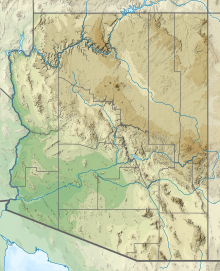| Baboquivari Peak Wilderness | |
|---|---|
 View of the east face of Baboquivari Peak | |
| Location | Pima County, Arizona, U.S. |
| Nearest city | Tucson, Arizona |
| Coordinates | 31°47′29″N 111°34′32″W / 31.7914724°N 111.5756642°W[1] |
| Area | 2,065 acres (836 ha) |
| Designated | 1990 |
| Governing body | Bureau of Land Management |
The Baboquivari Peak Wilderness or La Bestia is a 2,065-acre (8 km2) wilderness area in the U.S. state of Arizona. It is located in the Baboquivari Mountains 50 miles (80 km) southwest of Tucson, Arizona.[2] It is administered by the Bureau of Land Management. The United States Congress designated the Baboquivari Peak Wilderness in 1990. It is the smallest such designated wilderness in the state of Arizona. Today, the 2,900,000-acre (12,000 km2) Tohono O'odham Nation (second largest reservation in the United States) lies to the west. Baboquivari Peak's elevation is 7,730 feet (2,356 m). It is a popular site for many climbers, tourists and other visitors to Arizona and can be seen in the distance from the Kitt Peak National Observatory.

Baboquivari Peak is a technical summit, meaning that it is only accessible by technical (class 5) rock climbing according to the Yosemite Decimal System. The wilderness is reported to have some of the best backcountry rock climbing in Arizona. It can be visited any time of the year; however, outside visitors who are not members of the Tohono O'odham nation, must first procure a permit to be on the reservation. Also, summer afternoons are usually too hot for hiking, and winter can bring an occasional snow shower to the peak's highest elevations. Sightings of jaguars have been recorded in the Baboquivaris during the last decades.[3]
- ^ "Baboquivari Peak Wilderness". Geographic Names Information System. United States Geological Survey, United States Department of the Interior. Retrieved June 23, 2012.
- ^ "Baboquivari Peak Wilderness Area". Bureau of Land Management. Archived from the original on June 17, 2015. Retrieved January 17, 2015.
- ^ Mccain, Emil B.; Childs, Jack L. (2008). "Evidence of resident jaguars (Panthera onca) in the Southwestern United States and the implications for conservation" (PDF). Journal of Mammalogy. 89 (1): 1–10. doi:10.1644/07-mamm-f-268.1. S2CID 58923352. Archived from the original (PDF) on March 3, 2016. Retrieved January 17, 2015.

